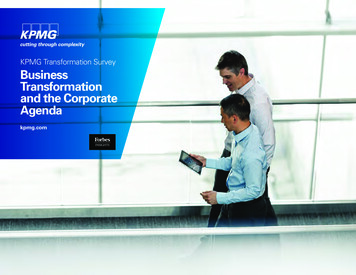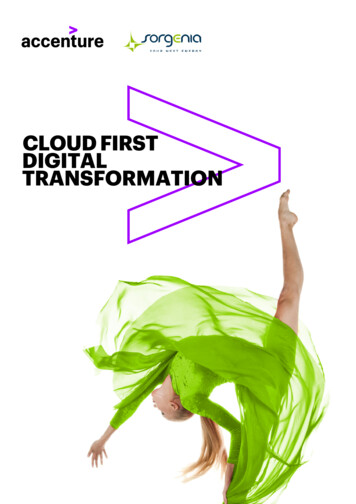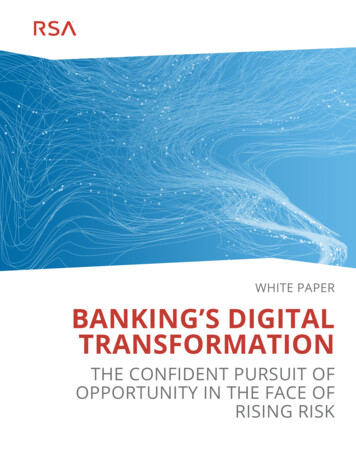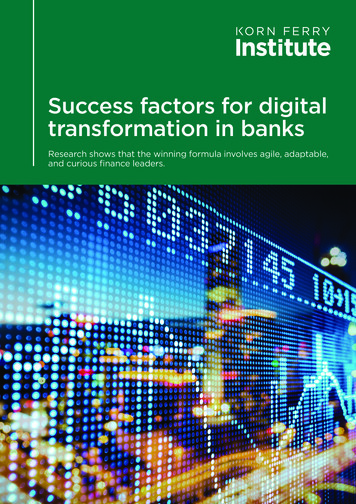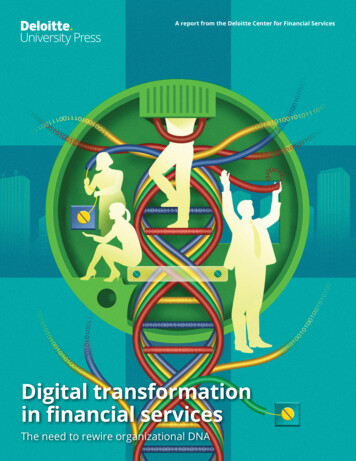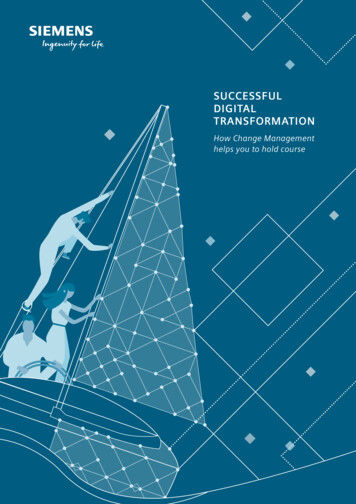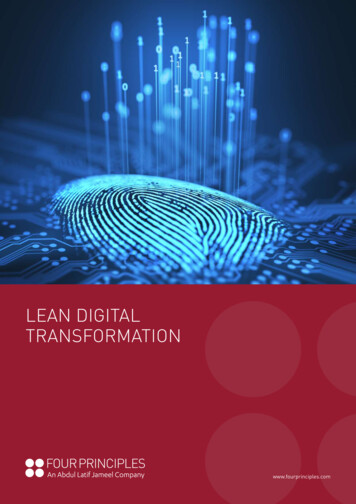
Transcription
LEAN DIGITALTRANSFORMATIONwww.fourprinciples.com
BACKGROUNDBIGGEST DIGITALTRENDSWe live in an age where the change andinnovation rate is so high, that value residesincreasingly in real-time relevant information.Keeping your company at the tip of the spearrequires a lot of focused effort and changemanagement experience.1. Through the use of technologies such as 3Dprinting, the products are being brought back fromlow-wage countries to sales markets in proximity totheir customers, this is known as Next-shoringCompanies that embrace the digitaltransformation trends are disrupting theirindustries by becoming fast, flexible andlow-cost players. They bring changes to theconsumer environments/ecosystems through:2. Companies connect to their customersthroughout the lifecycle of the product and throughthe Co-creation and Concierge principle, they involvetheir customers in the design of the services/products, helping the company to understand betterits customers’ needs and allowing them also to offervalue-adding services in targeted ways Digital technology penetration, by proposingways to create value that goes from humaninteractions to augmented reality interfaces orself-learning systems Digital products and services markets, whichallow the consumer to define his customerjourney within a controlled environment Very high paced digitization initiatives, wherethe working and interacting environmentsare moving to a higher level of automationand connectivity, where any equipment or anyproduct can immediately feedback the user withrelevant information about performance andefficiencyThe top trends in any sector, from heavyindustry to services and from healthcare toF&B, confirm that today it is mandatory toimplement a Lean digital transformation if acompany wants to keep the competition at bay.3. The Capacity Exchange is a type of outsourcingpractice that enables companies to manage thecompany’s peak capacity needs by allocatingindividual jobs to suppliers through digitalmarketplaces4. In an interconnected and automatedenvironment, Intelligent Order Creationautomatically allocates jobs to different suppliersof products or services depending on the job needs,service or product configuration, supplier capacityand capability, etc.5. Autonomous Control Loops are used inproductive and administrative systems whichare controlled through a series of parameters orperformance indicators that are monitored online,and through artificial intelligence features, thesystem can autonomously adapt the performanceand apply automatically corrective actions, or raisethe necessary flags for the human interface toperform a corrective actionCopyright 2018 Four Principles Management Consulting FZ-LLC1
SYSTEMS OFENGAGEMENT:KEY DRIVERS OFA LEAN DIGITALTRANSFORMATIONBefore going into the details of what a Leandigital transformation entails, we need tounderstand that the main components anddrivers of a Lean digital transformation, are thesystems of engagement.The systems of engagement are the vehiclethrough which the user interacts with digitaltools/trends on a daily basis. Systems ofengagement are dynamic and use close-touser apps or platforms whose value is linkedto the level of user engagement measured interms of number and quality of interactions.Examples of systems of engagement are socialapps like LinkedIn and Facebook, or businessplatforms like Uber and Airbnb, which evolvethe long-standing IT paradigm of systems ofrecord, which are based on significant legacydata storage and retrieval systems such ascorporate ERP modules used today.BIGGEST DIGITALTRENDS6. Human-Robot Interaction (HRI) refers to theunderstanding, designing, and evaluation of roboticsystems for use by or with humans, where bothhuman and robots need to communicate or interact7. Omni-channel Experience, is a cross-channelexperience that companies offer to enhance theircustomers experience by allowing the companyto own their data and experience, giving them theability to use it to guide creation and context of everyfuture experience: the ability to have a continuousexperience across brands and channels, acrossformats and across devices that is completelybespoke8. The action of selling and buying online is knownas e-commerce. This concept is widely known and isbased on the use of a platform to showcase productslinked with payment vehicles and connected todistribution companies that make the buyingexperience seamless9. Big Data Analytics tends to refer to the use ofpredictive analytics and mathematical algorithms toextract value from the data available in a particularenvironment.Copyright 2018 Four Principles Management Consulting FZ-LLC2
The goal of creating a system of engagement isto increase the user engagement with highquality user experience paired with high userrelated value creation: more value generationtranslates into more engagement, moreinvolvement brings in more data generated,more data generated can be converted again inmore value generation.Understanding the mechanics of systems ofengagement is the foundation to define a LeanDigital Transformation Agenda which in turn isthe starting point of setting up the full Digitaltransformation effort.BIGGEST DIGITALTRENDS10. Intelligent process automation encompasses fivecore technologies that aim to remove the repetitive,replicable and routine tasks by mimicking theactivities carried out by humans, learning them anddoing them better:a. Robotic Process Automation (RPA), whichperforms rules-based tasks and automates them.b. Smart workflow which is a process-managementsoftware tool that integrates tasks performed by agroup of machines or humans, allowing end-to-endvisibility of tasks status and seamless handoversbetween nodesc. Machine learning / Advanced Analytics arealgorithms that identify patterns in structured datasets through ‘supervised’ and ‘unsupervised’ learning.Copyright 2018 Four Principles Management Consulting FZ-LLC3
DIGITAL WASTE &DATA PROFITBIGGEST DIGITALTRENDSAn effect of the high paced rise in the numberof systems of engagement is an exponentialgrowth of available unstructured data – in theform of text, videos, audio messages, etc.d. Natural-Language Generation (NLG)software that creates seamless interactionsbetween humans and technology by followingrules to translate observations from data intounderstandable prose facts.e. Cognitive agents that combine machinelearning and natural-language generationto build an utterly virtual workforce that canexecute tasks such as communicating, learningfrom data sets or even suggesting (and making)decisions based on data available.This unstructured data is a potential source ofrelevant information, and therefore a potentialsource of value that can be ‘harvested’ throughdata analytics tools. However, currently, themajority of information is wasted and fadesaway unutilized and unaccounted for.Digital waste is defined as all the data that isnot accounted for, or combined in redundant,wrong or misleading information: whoever isunable to harness the ‘wealth’ of data available,wastes precious assets.Data profit is defined as all data combined withrelevant information for the user, permittinghim to make the correct choices.11. Blockchains are a list of records, alsoknown as blocks, which are linked andsecured using cryptography. These blocksare stored and accessed in a decentralizedway. They do not rest on a single server, butin many servers in the cloud, which is whyblockchains are potentially suitable for therecording of events, medical records and otherrecords of management activities includingidentity management, transaction processing,documenting provenance, food traceability orvoting.Copyright 2018 Four Principles Management Consulting FZ-LLC4
LEAN DIGITAL: WHAT IS IT?Lean focuses on eliminating traditional waste whilemaximizing customer value. Lean Digital concentratesinstead on eliminating digital waste while maximizingdata profit.Through Lean Digital, the digital waste is removed,this implies a substantial improvement of the userexperience and the user engagement.Furthermore, this will activate a ‘virtuous’ circlepermitting to boost data generation and userexperience further continuously.This creates the optimal environment for sustainablechange through Lean digitization.Copyright 2018 Four Principles Management Consulting FZ-LLC5
DIGITAL TRANSFORMATION MAINCHALLENGESThe creation of systems of engagement and the increase of data profit is challenging for most companies becausetraditionally they are more used to evolve their IT systems (Systems of Record based on legacy data storage) ratherthan revolutionizing them. Most businesses have understood that they need to move toward apps and platformsgenerating high-level engagement of their ecosystem of users, but most of the time they fail in their attempt due toa lack of attention in designing the right user experience.On the first companies are merely late in defining their digital agenda and are under a tremendous amount ofpressure from their competitors and customers to overcome the challenges that call for a digital transformation,like: Improving the customer experience Acquiring entirely new capabilities in: Running tighter cost controls- data analytics Achieving higher performance from the workforce- mobile technologiesand changing the ‘legacy mindset.’- social media Generating higher employee engagement Rethinking business models and strategies Retaining current talents and attracting new ones Continuously launching new ideasIn addition to these challenges, many companies have not even started to work on the basics to reduce traditionalLean waste embedded in their processes, organization, products, and services, leading to an increased and criticaldegree of non-transparency and complexity.Copyright 2018 Four Principles Management Consulting FZ-LLC6
LEAN DIGITAL TRANSFORMATIONLean Digital Transformation is Four Principles’ approach to support companies in defining and implementingsuccessful Lean digital agendas with initiatives both removing traditional and digital waste from their processes,organization, products, and services, to radically improve the experience of their ecosystems of users.To correctly kick-off a Lean Digital transformation, management has to set-up the necessary Lean digitaltransformation building blocks:1. Define a clear Lean digital vision: cascading down Internal talent, not only concerning skills butfrom the top management to the operators/clerks inalso regarding motivationthe company. This vision should include a defensive Technology availability and its scalabilitytarget that increases the level of competitiveness Quality of data available in the company toin the business arena and, at the same time ansupport the implementation and enable futureoffensive (disruptive) target that changes the ‘rules ofgrowth in app capabilitythe game.’3. Identify a base of users that are prepared to engage2. Define an ambitious yet achievable execution plan:that takes into account the available capabilitieswith the systems of the company both internally and inthe marketregarding:Copyright 2018 Four Principles Management Consulting FZ-LLC7
Therefore, the Four Principles approach to a Lean Digital Transformation includes the:1. Generation of transparency on strategy, at corporate4. Implementation of traditional Lean projects toand business level, which is supported by the definitionensure that processes, structure, products, andof the future state Lean Digital visionservices are optimized in parallel to the definition andexecution of the Lean digital projects guaranteeing2. Design of different Lean digital value streams,mindset change and sustainabilitywhich will be the basis to analyze and to understandinteractions and customers’ needs along the value5. Implementation of Lean Digital projects to definestreamsand establish systems of engagement3. Definition of a Lean Digital agenda, enabling theorganization to achieve the desired resultsCopyright 2018 Four Principles Management Consulting FZ-LLC8
LEAN USE CASESAs mentioned earlier, understanding themechanics of the systems of engagement is thefoundation to defining a Lean Digital Agenda,and to understand the mechanics of thesystems of engagement, it is designed by usingthe Lean use case technique.The Lean use case is a document used toidentify, clarify, and organize requirements ofSystems of Engagement (SoE). The Lean usecase is made up of a set of possible sequencesof interactions between SoE and users relatedto a particular goal that has value for the user.A LEAN USE CASE CAN BE THOUGHT OF AS ACOLLECTION OF POSSIBLE SCENARIOS ASSOCIATEDWITH A SPECIFIC PURPOSE, IT: Organizes functional software requirements Models the goals of system/user interactions with thelowest level of information waste Records paths (called scenarios) from trigger events togoals Describes one main flow of events (also called abasic course of action), and possibly other ones, calledexceptional flow of eventsCopyright 2018 Four Principles Management Consulting FZ-LLC9
FOUR PRINCIPLES’ SCOPE OF SUPPORTIt is important to state that Four Principles’ support covers most but not all the activities of a Digital StrategyFramework.Market and competitive analysis and vision, businessand corporate strategy definition are not includedin the output provided by Four Principles. Thesedeliverables are an input that Four Principles takesinto consideration to develop and implement the mosteffective digital agenda for the Client, leading the Clientin completing its Lean Digital Transformation.In the execution phase, Four Principles is coordinatingthe activities of an IT partner that is taking care ofthe coding and testing of the software linked to thedesigned use cases, thus ensuring on-time delivery ofthe specified app.Copyright 2018 Four Principles Management Consulting FZ-LLC10
EXPECTED BENEFITSThe benefits of a Lean Digital transformation mustbe explored in the perspective of the users in theecosystems of engagement:END USERSCreating engagement in a digital channel with endusers through an improved customer experience(enhanced service associated with product delivery,personalization of the commercial offer, etc.) boostsrevenues and sets the foundation of customer loyalty.Today, being the first to offer a unique customerexperience, sweeps any competition out. Moreover,the generated engagement of end users permits acompany to better profile their needs and to enhancefurther itscommercialBusinesses have seen adecrease of management proposal.Typically, retailcost of over 40% within abusinessesyear of implementation.that embraceomnichanneland digitized shopping experiences have seen a rise inmarket penetration, and a decrease of managementcosts of over 40% within a year of implementation.TOP MANAGERSExecutives without the right information cannotmake the right decisions about markets, resourceallocation, technologies, and partnerships. In this case,engagement can be created by providing a properbusiness intelligence system that permits them tomake the correct decisions at the appropriate time.Having the information at hand has allowed heavyindustries to reduce by 10% to 20% the amount ofwaste generated in production lines, while for example,in companies heavily dependent on commoditiesprices, the application of big data analytics has reducedtheir risk exposure by 35%.OPERATIVE ASSOCIATESIn any operational environment associates’ decisionshave an impact on process performance (e.g.,manufacturing, maintenance, logistic processes). Ifprovided information is real-time and relevant, theeffectiveness of countermeasures to internal issuesincreases dramatically. The real-time data on processperformance canbe even treatedIt has allowed heavywith statisticalindustries to reduceinferencethe amount of wasteto identifygenerated in production correlationslines by 10% to 20%.that permitto determinethe sources of traditional waste very preciselyand ultimately to remove them. For example, theapplication of independent control loops in thepetrochemical industry has facilitated the reduction ofbreakdowns by up to 60% in specific equipment.BACK-OFFICE ASSOCIATESBack-office activities concern most of the timecompliance with well-defined standards (e.g., legal,finance, administration, HR activities). Specific appsthat harness the tool of data analytics and datascience can give immediately to back-office usersprecious information that otherwise is very difficult tobe extracted in traditional IT environments. The useof cognitive agents has allowed HR departments toassess more effectively the performance of managers,reducing by over 30% the turnover of personnel andloss of talent.The use of cognitive agents hasreduced the loss of talent by 30%.Copyright 2018 Four Principles Management Consulting FZ-LLC11
Should you be interested to know more about our Lean servicesregarding this topic, then please contact us:Tel 971 4 368 2124Emailinfo@fourprinciples.comDubai, UAE Office AddressDubai Media CityBuilding 8Office 212P.O. Box 502621Dubai, UAECopyright 2018 Four Principles Management Consulting FZ-LLC12
A LEAN DIGITAL TRANSFORMATION Before going into the details of what a Lean digital transformation entails, we need to understand that the main components and drivers of a Lean digital transformation, are the systems of engagement. The systems of engagement are the vehicle through which the user interacts wit
